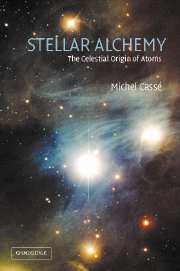Book contents
- Frontmatter
- Contents
- Preface
- Acknowledgements
- 1 Nuclear astrophysics: defence and illustration
- 2 Light from atoms, light from the sky
- 3 Visions
- 4 Contents of the sky: atomic sources and fountains
- 5 Nuclear suns
- 6 Sociology of stars and clouds
- 7 Histories
- 8 Ancient stars in the galactic halo
- 9 Conclusion
- Appendix 1 Invisible matter and energy
- Appendix 2 Supernovas and cosmology
- Appendix 3 Explosions
- Appendix 4 Stellar nucleosynthesis
- Appendix 5 Galactic evolution
- Appendix 6 Key dates
- Appendix 7 Constants and units
- Appendix 8 Websites
- Bibliography
- Index
1 - Nuclear astrophysics: defence and illustration
- Frontmatter
- Contents
- Preface
- Acknowledgements
- 1 Nuclear astrophysics: defence and illustration
- 2 Light from atoms, light from the sky
- 3 Visions
- 4 Contents of the sky: atomic sources and fountains
- 5 Nuclear suns
- 6 Sociology of stars and clouds
- 7 Histories
- 8 Ancient stars in the galactic halo
- 9 Conclusion
- Appendix 1 Invisible matter and energy
- Appendix 2 Supernovas and cosmology
- Appendix 3 Explosions
- Appendix 4 Stellar nucleosynthesis
- Appendix 5 Galactic evolution
- Appendix 6 Key dates
- Appendix 7 Constants and units
- Appendix 8 Websites
- Bibliography
- Index
Summary
Aims and aspirations of nuclear astrophysics
The aim of nuclear astrophysics is threefold. Firstly, it seeks to determine the mechanisms whereby the various nuclear species occurring in nature are built up, from deuterium with its two nucleons to uranium with 238 nucleons. Secondly, it seeks to identify the astrophysical site in which these species are produced. And thirdly, it attempts to unravel the temporal sequence of the nuclear phenomena that fashion baryonic matter, the stuff of stars and humans, making up the galaxies. Beyond this, it aims to explain the composition of the Solar System and the main trends of chemical evolution in the Galaxy, such as the gradual enrichment in metals and the relative abundances of the elements. It explores in detail everything from the first stages of chemical evolution in the Universe through to the most recent and violent events of nucleosynthesis related for the main part to supernovas and large stars with strong stellar winds (Wolf–Rayet stars). Indeed, gamma photons of precise energies are emitted by the freshly fashioned nuclei in high-wind stars and supernovas, radioactive nuclei in search of their ultimate form. Without a doubt, these high-energy photons constitute the purest clues as to the mechanisms producing atomic nuclei in the Universe. Hence, the spectroscopy and mapping of celestial gamma sources should provide us with fresh evidence of nucleosynthesis and locate its centres in our own galaxy and beyond.
- Type
- Chapter
- Information
- Stellar AlchemyThe Celestial Origin of Atoms, pp. 1 - 10Publisher: Cambridge University PressPrint publication year: 2003



